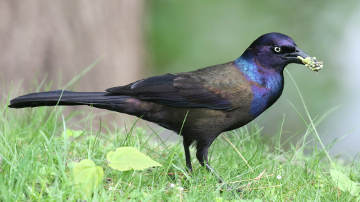

PHOTO COURTESY OF GARRY KESSLER
Common grackle.
November 2, 2018, Page A9
NATURE NOTES
By Annie Reid
Westborough Community Land Trust
Who’s who in those big flocks of blackbirds?
Have you ever wondered about the large flocks of blackbirds that migrate through our area, going south at this time of year, or north in early spring? You might see them flying overhead, perching on wires, or descending into a field or trees. These mixed flocks often contain large numbers of grackles, in addition to familiar red-winged blackbirds, European starlings, and others.
How can you tell who’s who? From a distance, all the birds look black, and they are in fact mostly black. Common grackles (Quiscalus quiscula) are about the size of a blue jay. You can often spot them because they’re larger than the red-winged blackbirds (Agelaius phoeniceus) and the European starlings (Sturnus vulgaris). They also have noticeably longer tails, although their relatives, the boat-tailed grackles (Quiscalus major) in Florida and the great-tailed grackles (Quiscalus mexicanus) in Texas, have even longer tails.
You might get a close-up view of a common grackle if some of them land in your yard to walk around and eat spilled seed under your birdfeeder, or if you find grackles foraging at the water’s edge of a pond or stream. Then you might see that they have color – a glossy purple or blue-green iridescent sheen, perhaps with bronzing on the back. Male and female common grackles look similar all year long, but males are somewhat brighter and slightly larger.
In contrast, at this time of year red-winged blackbird males look brown-black but the small part of their famous red shoulder patches that you can easily see may look tan. (Female red-wings remain streaked with brown, somewhat like sparrows.) European starlings are quite pretty now, with light speckles and gold or cinnamon edges on the feathers on their wings and back.
Group living is a way of life for common grackles. They often migrate in huge flocks during the day and roost together at night. For example, according to Forbush Bird Club records, last fall on October 22, 2017, 1,200 grackles were reported in Westborough, and in the previous year, on March 24, 2016, 8,000 were reported in Westborough. Grackles are known to have magnetite, an iron-containing mineral, in their heads and necks, and it may help them sense and navigate by the earth’s magnetic field during migrations.
Common grackles also forage together on the ground, in small or large groups. And they usually nest together in groups of 10-30 pairs, typically in evergreens (where they’re hard to observe) near open areas such as fields or near water. Some pairs nest alone.
Common grackles are native to North America and have flourished as they’ve adapted well to human influences on the environment. They prospered as European settlers arrived and cleared forests for farm fields, creating more places where grackles could feed and nest.
Today common grackles are found throughout eastern North America, including in cities and towns. They can be a pest of grain crops in many places. In our area flocks forage in agricultural fields, especially for corn (at places such as the Wildlife Management Area fields in Westborough). They also eat bird seed and acorns, which they can easily break open thanks to a special ridge on the inside of their upper beak. When nesting and raising chicks in the spring, they consume insects, including caterpillars and grasshoppers. They’ll also eat garbage, small birds, small fish, frogs, and whatever else they find.
Next time you see or hear a flock of blackbirds, either this fall or early next spring, see if you can tell who’s who.
Date index
Month (November)
Common name index
Scientific name index
Category index